As important as your next breakfast burrito might be, there’s a difference between picking up your smartphone to find good Mexican food and seeking a local healthcare provider. People take their healthcare needs seriously. Finding the right surgeon, dentist, or primary care physician is very often a life decision.
Nearly 60 percent of patients will not choose a healthcare provider
due to negative online reviews (NRC Health)
Today, many people evaluate healthcare providers based on what they find online. They visit provider websites and read online reviews. A recent NRC Health Study, for example, estimates that nearly 60 percent of patients have selected a doctor based on positive reviews they read online.
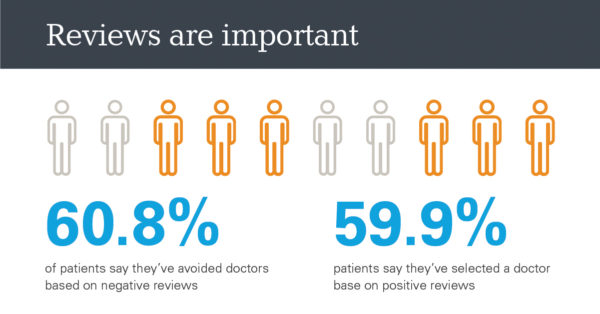
What’s more, upwards of 60 percent of patients disqualified a doctor or provider based on negative online views. Overall, the study finds that 34 percent of patients consider online reputation quite important in their decision-making process.
How to Build a Thriving Digital Reputation
A common mistake that brands across all industries make is resting on their laurels. They spend all of their marketing capital on advertising campaigns and outbound communications while neglecting their online reputation.
RELATED: Why You Can’t Neglect Your Digital Reputation
While a certain amount of reviews and engagement will happen organically, depending on how strong your brand already is, you might be waiting a long time to see any significant lift. Without taking action to encourage positive reviews, you’ll likely have more negative reviews floating around out there. Left unchecked, this kind of negative sentiment can become a prevailing part of your digital presence.
Instead, here are three fundamental pieces to a baseline digital reputation program. It’s the framework we use with our clients to help generate more patient reviews, strengthen digital reputation across all channels, and ensure that poor reviews—or none at all—aren’t turning new patients away.
1. Monitor and Manage Your Digital Profiles
Like so many digital marketing strategies, reputation management often begins with taking an inventory. What digital profiles, sites, channels, and listings do you currently have today (whether you maintain them or not)? Where do your healthcare consumers go to read and leave reviews for your brand? Usually, this list includes the following channels, in one form or another:
- General healthcare review websites (ZocDoc, RateMD, Vitals, Healthgrades)
- Specialization-specific review sites (dentistry, plastic surgery, etc.)
- Provider listings on healthcare networks, medical groups, and insurance groups
- Google Maps, Bing Maps, and Google Search listings
- Google My Business, Yelp, and Facebook Business
- Embedded reviews and testimonials on your website
- Social media profiles, such as Twitter, LinkedIn, Instagram, Facebook, and YouTube
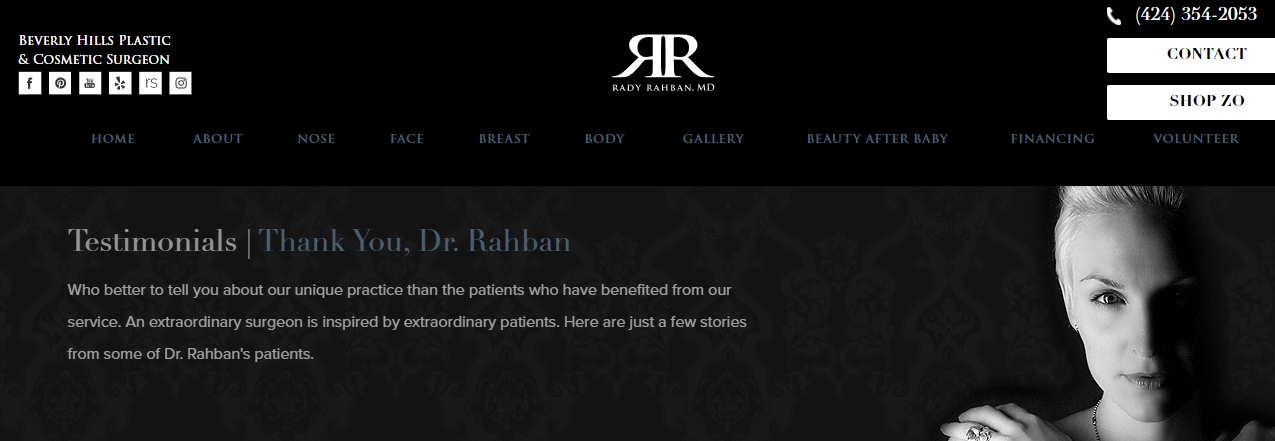
After you take an inventory of what comprises your digital presence, devise a strategy to address any issues, prioritize what needs to be updated, and formulate a review response plan. Be sure to provide specific guidance that can be formalized and disseminated throughout your organization, including:
- Creating and maintaining listings across all relevant channels
- Who is in charge of monitoring and responding to reviews
- How to handle negative reviews
- How to respond to positive reviews
- How to incorporate positive reviews and testimonials into your broader digital strategy
- How to add approved testimonials and review to your website and social media channels
- How to solicit reviews from patients
If nothing else, make sure to set up your Google My Business (GMB) listing. For multi-location healthcare practices, do so for each location! Alongside location-specific webpages, this is a crucial part of reputation management and local search strategy! To set up your GMB:
- Register for Google My Business.
- Complete the location verification process.
- Optimize your GMB listing by adding accurate NAP information, relevant business categories, and photos.
Beyond GMB, check out RealPatientRatings, RealSelf, and other healthcare-specific review databases and make sure your listings are regularly checked and updated.
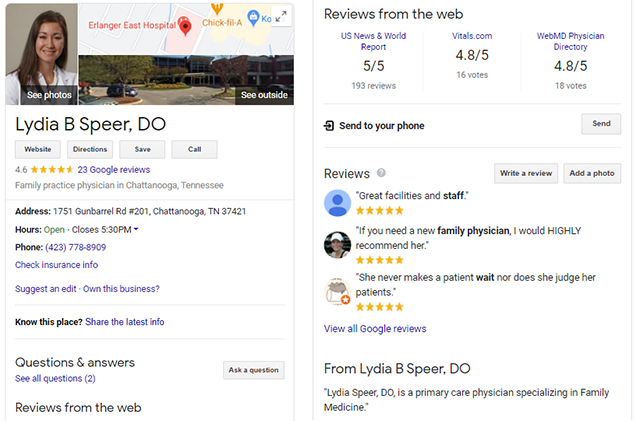
2. Develop A Review Solicitation Strategy
Conventional wisdom holds that a consistent influx of reviews, generated overtime, outweighs sheer review volume. Meaning, anyone can go out and generate a big pile of one-time reviews, then move on. You get more “juice” from a regular influx, as people want to see recent reviews—not a bunch from 2 years ago.
That’s not to say that your total number of reviews doesn’t matter. According to the same NRC Health Study referenced above, “74.7% of patients want to see at least seven ratings before they’ll trust them. 77.6% need to see seven comments that say the same thing before they’ll believe that there’s a trend.”
To build a high volume of ongoing reviews often takes a more formalized, organization-wide process for regularly soliciting reviews. Here are a few core tenets of a successful review solicitation strategy:
- Map review requests to key points in the patient journey. These might be the transactional emails and automated messages you send after an appointment or procedure. Maybe you solicit reviews through a mobile app, or over the phone. Ask yourself which points in the journey will give you a consumer warm to the idea of leaving a review.
- Train staff to ask for reviews. Give your staff members the script for when, where, and how to solicit reviews.
- Share your review form widely. Consider including a link to your review form in your automated email messages, SMS text communications, and popular web pages to encourage more customers to review your business.
- Automate your review solicitation program. There are great programs like BirdEye that can seamlessly integrate review solicitation with email, SMS, or even regular mail. Reputation management tools provide a great way to improve and monitor your digital reputation on an ongoing basis.
3. Strengthen Your Website Presence
A healthcare brand’s reputation extends beyond business listings and online reviews. As we’ve said elsewhere, many roads lead to your website. Whether they reach your site directly or indirectly, patients expect to find information and content that confirms their decision to pick you.
Start with your About page
We see a lot of lackluster About pages in healthcare. It’s such a missed opportunity! Your About page is an opportunity to introduce patients to your team—to give them a feel for your depth of experience, background, and reputation. It’s a chance to put a face to names and deploy a bit of storytelling to describe how your practice came to be and what it’s all about
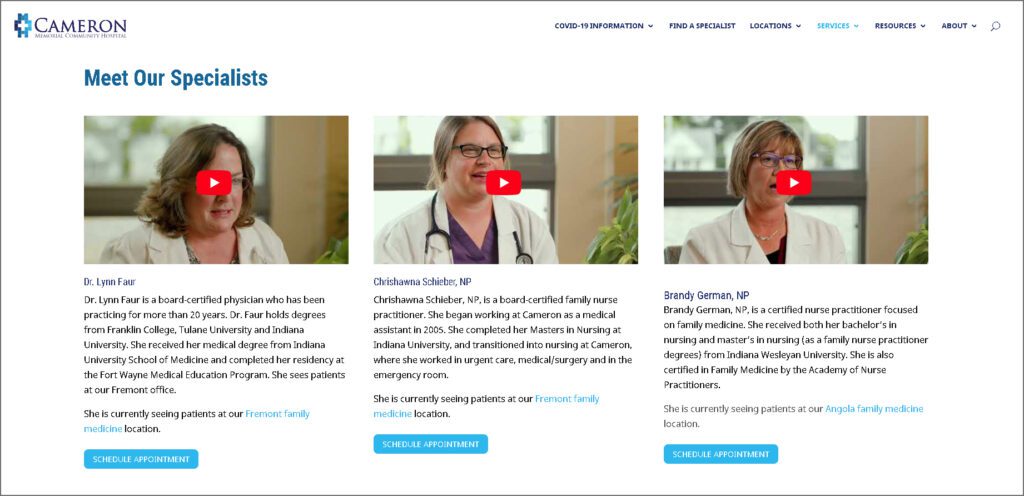
We like this bit from Pratik Dholakiya writing for Business.com: “They want to know your story and judge whether you ‘get them’ and their problems. They want to understand why you’re doing what you’re doing. Therefore, if you create a personal, likable, and believable About page, your prospects are more likely to be comfortable buying from you.”
Write patient-first mission and value statements
The same goes for your mission and values statements. Rather than writing the same generic statements that you find on every other healthcare provider’s website, why not write mission and value statements based on what your patient needs?
Consider working with a third-party agency to bring your mission, values, and other core “brand” statements to life on your site. The creative exercise alone can uncover interesting approaches to writing and presenting this information across your various marketing channels.
Showcase your positive reviews
Don’t you want prospects to know that people just like them love you? Whether you thread them throughout your site or post them to a dedicated “patient review” or testimonial page, it’s important to incorporate your reviews onto your site. Visitors to your site want to see reviews, testimonials, and patient stories that give them an idea of your reputation as a provider.
Beyond embedding reviews from Google, Facebook Business, and other review sites, build out a library of approved customer quotes (including a headshot and name) that can be used on various web pages. Many healthcare brands are now investing in video testimonials, such as post-op conversations, as well as longer-form patient stories and case studies. Here’s a strong example from the University of Arkansas for Medical Sciences (UAMS):
Bonus Tip: Look for Blindspots!
This is where we encourage healthcare brands to mimic their friends in the software industry. Many leading software brands analyze user sentiment, negative reviews, and customer service case volume around particular issues, to reveal “friction” in their user journeys. They look for things that trip customers up, frustrate them, or cause them to pick up the phone and dial support.
In a word: they turn what their users are telling them into actionable data.
Healthcare brands can do the very same thing. If 90% of negative reviews left in the past year, for example, mention how difficult it is to schedule an appointment, this might be a part of the patient journey that bears closer scrutiny. A more formal analysis—perhaps done by an AI-powered sentiment analysis solution—might reveal that most negative patient sentiment is clustered around “telehealth.” It might time to look at how you can make your remote consultations easier on patients.
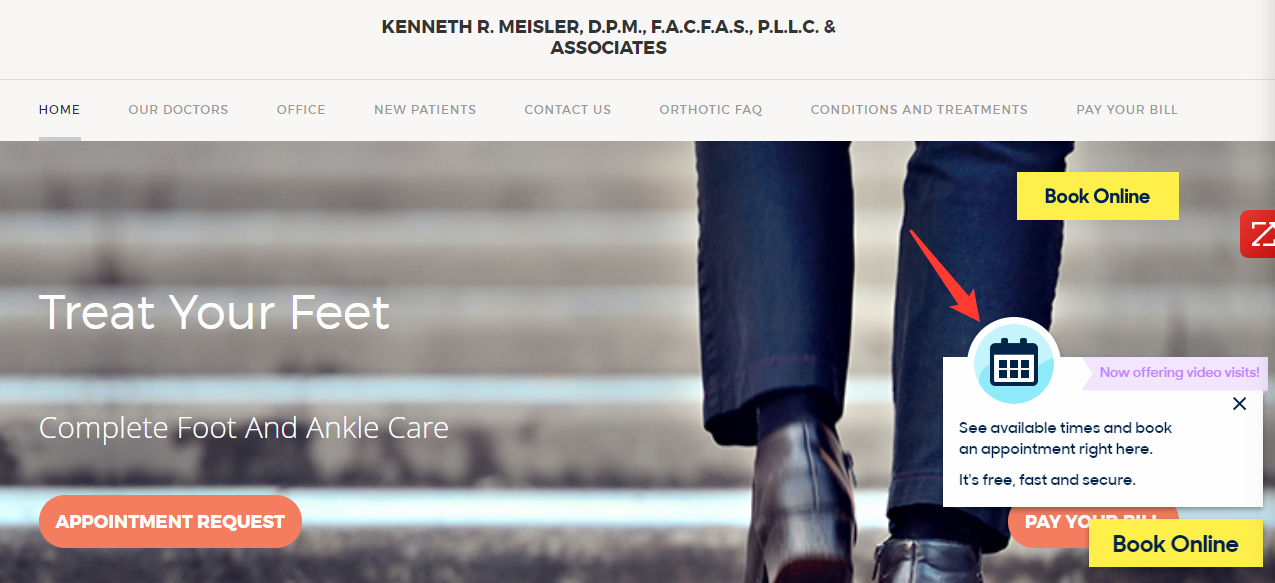
Taking Tangible Steps to Build the Intangibles of Your Digital Reputation
We’ve expounded here at length about the practical steps you can take to improving your digital reputation. To recap:
- Shore up your digital listings
- Solicit reviews on an ongoing basis
- Bring your website up to speed
Let’s not forget, however, the more intangible parts of any brand’s reputation, be it that of a healthcare organization, business leader, or otherwise. Patients especially are drawn to brands that exude transparency and authority. They are looking for proactive communication and credibility builders. They’re keen on brands that bring value to their patient journey—that empathize with their particular experience. Many patients like to see a healthcare provider that’s active in their local community.
When all is said and done, reputation and management, healthcare marketing, and patient acquisition—it all comes down to what is a very personal experience for all of us. From who we choose to carry out our elective surgeries, to whom we entrust with our family’s dental care, we’re usually seeking a trusting, long-term relationship. Increasingly, a healthcare brand’s online reputation is the very first step in that journey.

